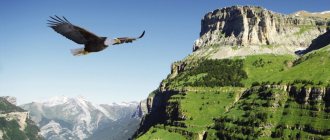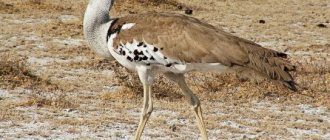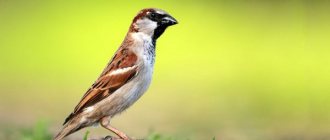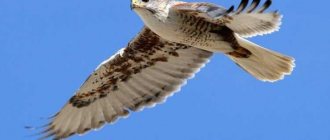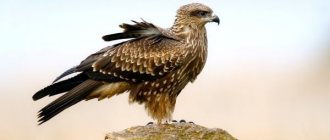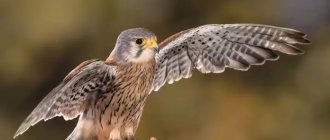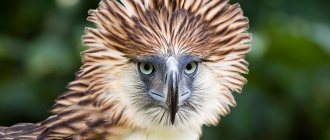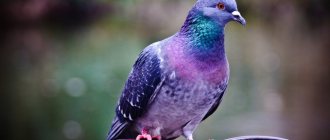Appearance
The steppe eagle is large in size and has a small rounded tail. In adult birds the color is brown, but with age it can become darker. Permanent color is formed only by the 6th year of life. Juveniles can be identified by a white stripe on the wing, while adults have transverse stripes that are located on the flight wings. They have a white spot above their tail.
Sexual dimorphism is expressed in size: the female is smaller than the male. The body length of males is approximately 70 cm, and in females this figure is in the range of 75-90 cm. The wing length of animals is about 60 centimeters. Males weigh from 2 to 4 kg, and females from 3 to 5.
Eagle - lion of the bird family in culture
If the lion is considered the king of animals, then the eagle is the king among birds. Ancient civilizations believed in a special connection between eagles and the sun. Thus, in Sumerian mythology there is a legend about how an eagle carried King Ethan to heaven. In Hinduism, the bird was associated with the god Vishnu, and among Buddhists - with Buddha. For the ancient Greeks, the steppe eagle was a symbol of Zeus. The Persians have the god Mithra.
The ancient Roman authors Lucan and Pliny the Elder wrote that eagles are not only able to look at the sun without blinking, they also determine which of their offspring is able to survive. If the chick blinked while looking at the light, it was thrown out of the nest.
Images of an eagle are one of the most common symbols in heraldry. Since ancient times, images of sitting and diving eagles on coats of arms have been known. No less common were images of eagle heads and wings as heraldic symbols.
The double-headed eagle was a symbol of the Byzantine Empire. Less known are images of three-headed eagles. A similar figure can be seen on the spire of the Grand Palace in Peterhof. There are legends about three-headed eagles in Chechen, Evenk and Yakut fairy tales. An eagle with three heads is mentioned in the apocryphal book of Ezra, which appeared in the first centuries of our era.
Images of eagles are present on the coats of arms of more than two dozen countries.
In the United States, there is a special law that allows the use of eagle feathers only for spiritual and religious purposes, and only by persons belonging to one of the federally recognized Indian tribes.
Photo: pixabay.com: UGC
Where does it live?
The steppe eagle can be found in the steppes and semi-deserts of northern Eurasia. Birds also live on the plains and in the steppe zones near the mountains. So, these animals inhabit Russia and Kazakhstan, China and part of Mongolia. The largest population is in Kazakhstan, its population is about 50 thousand bird pairs.
They winter mainly in Africa, especially in its southern and central parts, as well as in India and Turkmenistan. Russian steppe eagles prefer Uzbekistan for these purposes. This happens from the beginning of September until March.
Flight Features
Despite their considerable size, eagles have fantastic flight characteristics. They learned to fly without much physical effort. The secret of flight is the skillful use of warm air currents that lift the birds upward. This is also facilitated by special feathers located on the wide wings. Taking advantage of this, predators can circle over their hunting area for hours.
The flight speed can amaze even sports car owners. In a dive, an eagle can reach a speed of 320 kilometers per hour.
Thanks to the study of eagles, engineers made a breakthrough in the field of aircraft construction by inventing winglets, which is also the name for the wingtips of modern airliners. Despite their unimpressive appearance, they save a large amount of fuel and increase the flight performance of aircraft by 15%.
Unfortunately, the steppe eagle is a rare and endangered species today. The population of these birds is inexorably declining. This is due to the massive plowing of virgin lands, which destroys the main type of food - rodents. Another danger for eagles is metal power transmission poles. It is worth noting that thanks to this unusual bird, air travel has become economical, and photographic equipment has become more advanced.
What does it eat?
An eagle usually consumes about half a kilo of food per day, but often it deposits food in its crop, where it is stored for a day or two. The animal feeds on gophers, mice and rats, thereby being useful in the fight against these destroyers of agricultural land. It also hunts hares and small chicks of other species. Sometimes the steppe eagle also eats carrion, but less often – reptiles. The predator ate dead animals more actively when the saigas population was huge. 10 eagles swooped down on one carcass at once.
First, the bird tracks an object from a height, and then quickly rushes at the victim, having previously extended its paws and claws. Often the eagle will ambush near a gopher colony, using a hummock as cover. As soon as one individual moves away from the others, the predator grabs it and quickly runs away. There is a time when the number of gophers declines and then the steppe eagles do not create nests, but fly away in search of victims far from their habitat. Although usually only young individuals lead such a lifestyle.
Hunting methods, food
The predator's menu includes small steppe rodents, most often ground squirrels, hares, small reptiles, birds, chicks, eggs of birds and snakes. If he finds carrion, he will not refuse it. By eating the carcass, it will not conflict with birds arriving to feed.
Its hunting techniques are similar to other members of the hawk family. Excellent vision with a wide viewing angle allows you to notice small animals from a great height and track them. Having spotted prey, the eagle dives, putting its legs with sharp hooked claws forward to firmly grab the victim. If he is on the ground, he can track a gopher or other animal for a long time, being in ambush behind a stone or a small mound. Having waited for his appearance, he rushes at him or, if necessary, catches up - the eagle runs well.
It turns out that during periods of famine, when food is insufficient, for example, the population of gophers has decreased, the steppe bird does not begin to reproduce, but searches for food, leading a nomadic life.
Reproduction and parental behavior
Around April, animals are already preparing for the start of the breeding season. At the very first meeting of the future pair, the male flies not far from the female and, if she likes the territory of this individual, they become a pair.
These birds are monogamous, but if a partner dies, they will quickly find a replacement. Usually during the mating season they like to circle, dive and chase each other in the air for a long time.
Animals can create nests both on the ground and on the crowns of trees in a place where they can fly up from above. You can also find their nests on rocky ledges. In general, they like to find some high ground, such as a haystack, and nest there.
A bird's nest always has bedding made of manure, wool, and man-made materials: paper, rags. You can often see plastic with pieces of clothing there.
The female lays eggs in May. Usually their number does not exceed 4. Their shell is light in color with ocher spots. The break between hatching eggs is 3 days. The female incubates them for a little more than a month - approximately 40-45 days. The chicks are always of different ages, so often the smallest one dies due to lack of food. They live in the nest for about 60 days, but gain full independence when they are 75-80 days old. Eaglets feed on gophers.
Eye like an eagle
The detective from the cartoon “The Town Musicians of Bremen” (1969) boasted in a song that he had a nose like a dog and an eye like an eagle. The vision of birds is truly enviable. If the human eye is able to focus on only one object, then the eagle’s eye can focus on two at once. And it is protected for two centuries. Transparent protects the eye during flight, and opaque allows you to sleep.
From an altitude of 3000 meters, these birds of prey are able to see prey the size of an adult hare over an area of more than 11 km. The eagle's peripheral vision angle is 270 degrees.
Interesting Facts
- During the autumn migration period, eagles can fly 6 thousand kilometers. In spring, this figure drops to 4 thousand km.
- Birds can fly at an altitude of 7 kilometers, this figure is close to the flight altitude of an aircraft
- Animals can see a mouse at an altitude of 2 km; they have 5 times more sensitive cells in their eyes than humans.
- A lot of food can fit in the crop: about a third of the animal’s weight.
- The female cares for the chicks, and the male hunts.
- The voice of the birds is screeching. They make this sound during mating season and to call for food.
- The animals do not conflict with other pairs; they usually settle within a kilometer from each other.
Popular message topics
- Life of the forest
Many people think that a forest is just a lot of different trees and animals living in it, but this is a mistaken opinion. Residents of the city do not know that life is in full swing in the forest and many interesting processes are happening. The forest is its own world, in which a lot happens - Wrangel Island
Back in the 17th century, residents of Chukotka said that in the Arctic Ocean there is an amazing island, the existence of which no one knows. This unknown island appeared on maps after a long time. The new open area was named - Types of art
Types of art are usually divided into 3 main categories. The first is spatial forms of art. The second includes dynamic types (music, literature). And the third is responsible for space-time.
American symbol - relative of the eagle
The bald eagle, depicted on the US State Seal, is a relative of eagles and belongs to the same family. The founding fathers deliberately chose this bird so that the symbol of the new state would be different from the known ones.
Already by the 18th century, eagles were symbols of many powers. Therefore, the Americans chose their closest relative. It differs not only in appearance, but also in diet. Eagles eat fish.
They are also poseurs in the world of predators. To protect the territory and attract a female, the eagle puts on a show. It makes loud noises, swoops down, spirals, and displays aggression towards other birds.
Eagles: midlife crisis
People experience a midlife crisis around the age of 40. Having lived for four decades, eagles do not overestimate life priorities, like people, but they face serious physiological problems. The feathers on the chest thin out, causing the aerodynamics of flight to deteriorate, the claws become soft and difficult to grasp prey with, and the beak grows so large that it does not allow it to absorb prey.
The eagle undergoes rebirth for about five months. The beak falls off, and the eagle waits until the new one is strong enough. With it he plucks old feathers and gnaws limp claws. Having survived the rejuvenation procedure, the bird can live another 40 years.

